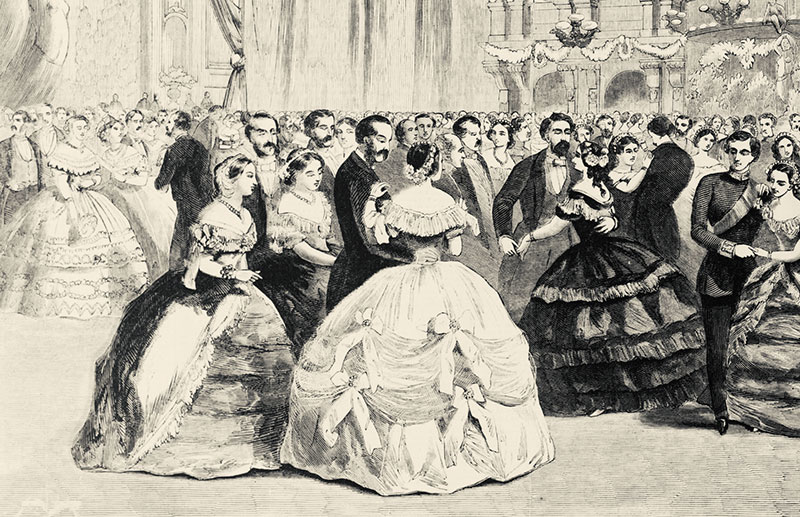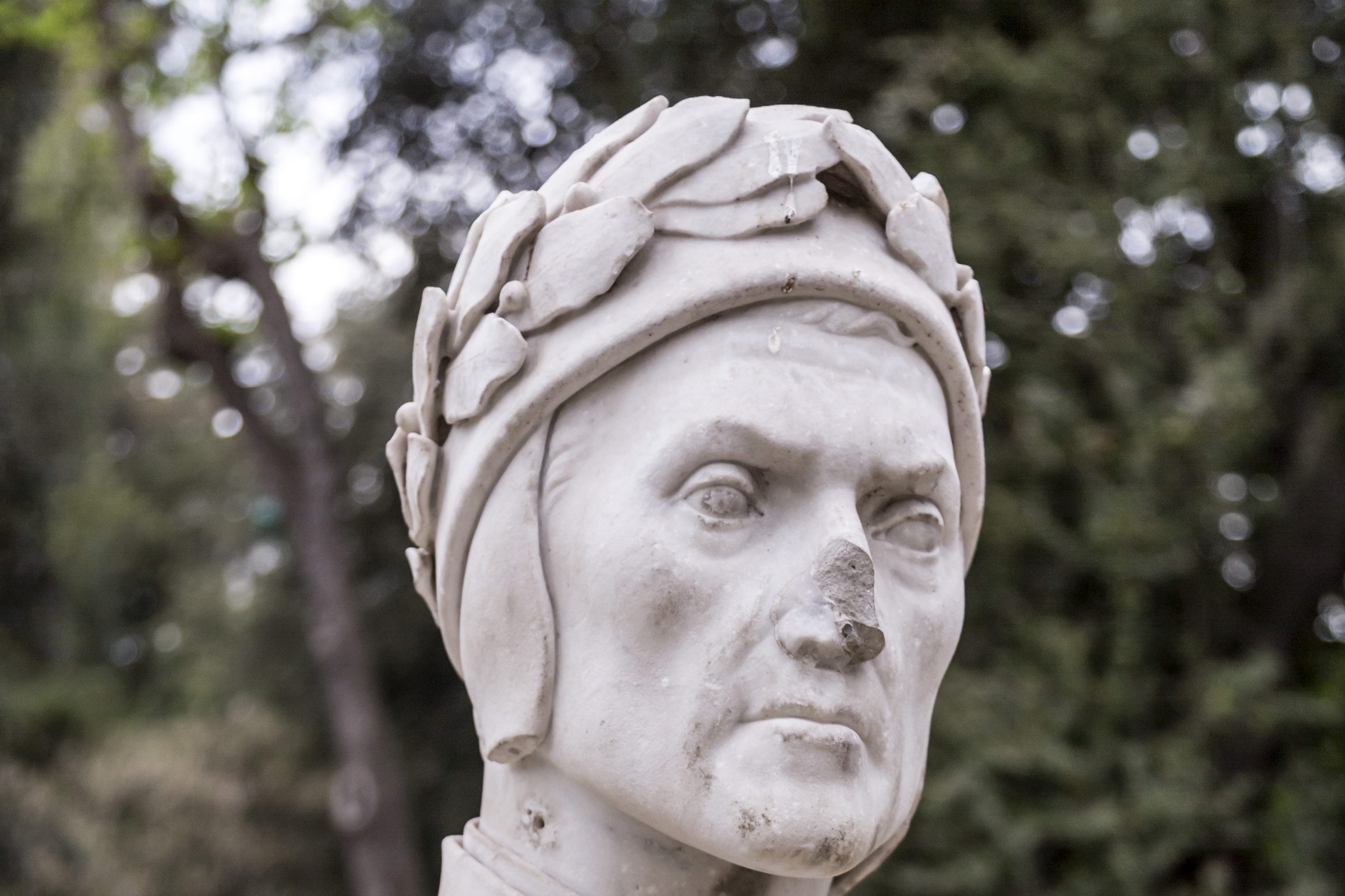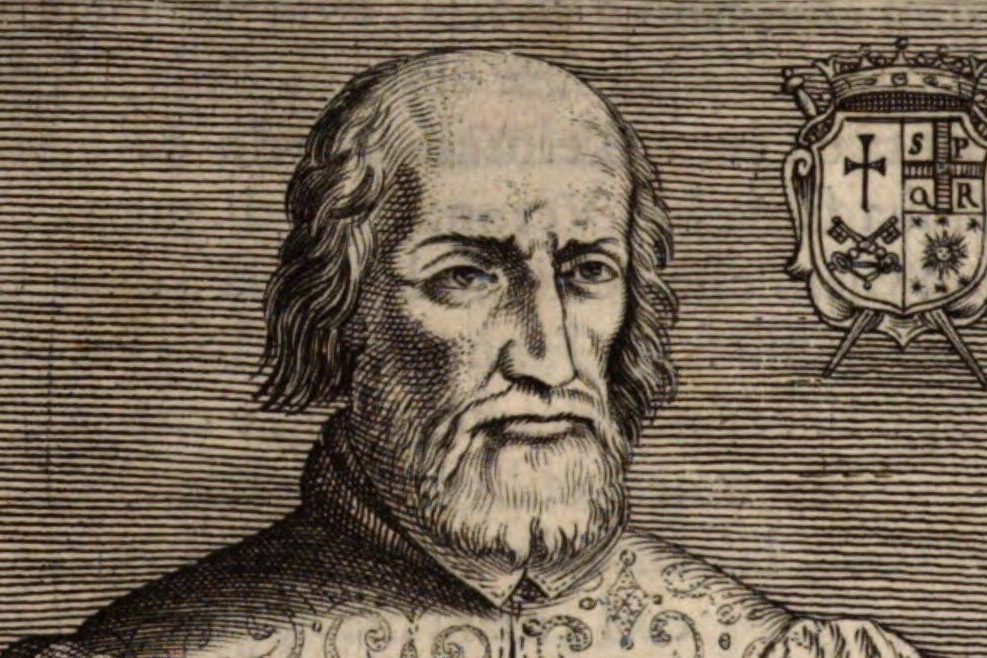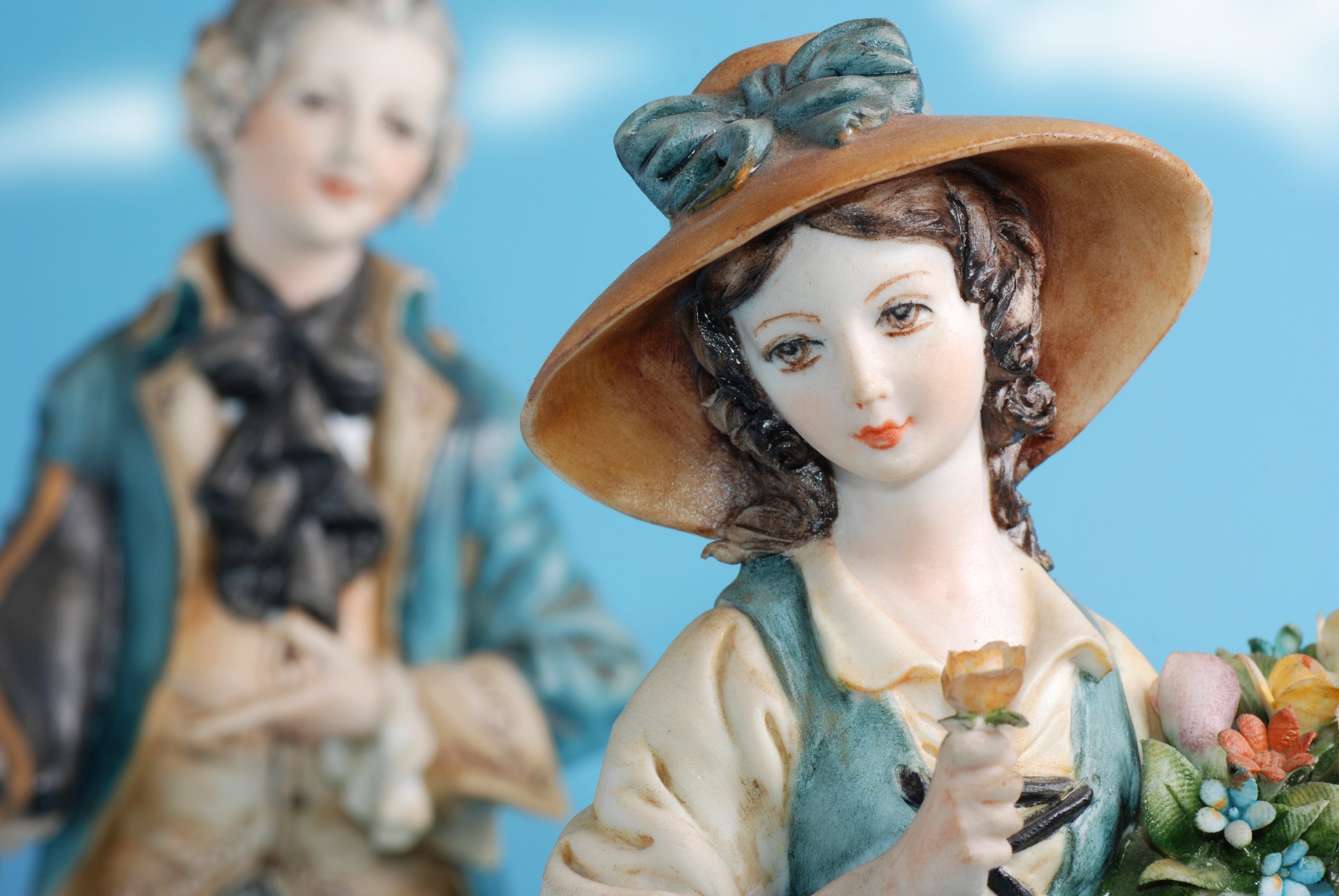For ten days in December, a scirocco paralyzed Rome. Traders, oblivious to a rise in corn, moped around the Triton Fountain in Piazza Barberini. Socialites, veiled and caped in otter, drowsed in park carriages on the Corso. From the loggia of Villa Lante al Gianicolo, the city resembled a Pompeii of ashes. Before Christmas, however, a ponentino blew in from the sea and revived the capital in time for the Quirinal Ball.
Built for popes and cardinals, the Quirinal was a bad place for midnight suppers and waltzes, despite its heroic makeover. After Unification, the new regime had replaced the palace’s images of saints and pontiffs with bigger-than-life paintings of the Risorgimento’s greatest moments. Decorators brightened the reception hall with yellow damask and hung a portrait of blue-eyed Princess Margherita in the ballroom. After eight centuries of Spartan austerity, the House of Savoy had acquired panache. Nevertheless, although the chic Margherita was now queen, public entertainments remained military drills.
It was a quarter-mile march down a cloistral corridor to the buffet table. Guarded by cuirassiers, the Swiss Hall was more forbidding than the Vatican. Tight security was necessary because of political conflicts. Rival guests stampeded to the reception line or scuffled over canapés and champagne, but this was nothing compared to the backbiting struggles for an invitation. Four liberal ministers had protested being omitted from the guest list. To prevent a government crisis, a palace dame of the Roman nobility was forced to resign and replaced with a bourgeois lady of the left’s choosing. When King Umberto was informed, he exclaimed, “Balls!”
Twelve hundred guests grazed at the buffet table and milled about near the throne room. Was it true that the Queen collected porcelain dinner sets from every province in Italy? What a touching symbol of national unity! The masters of ceremonies smiled, offered their arms and dance cards stamped with the Savoy crest, and escorted the ladies into the ballroom. All admired the crystal chandeliers and scarlet curtains, but some were ambivalent about the huge fir tree. Introduced to the palace five Christmases ago, it still seemed too German, a misplaced tribute to the Queen’s Saxon mother. Still, its blazing candles confirmed that the social season truly had begun.
At precisely eleven o’clock, one of the two doors on the opposite side of the hall opened. The orchestra played the fanfare to the Marcia Reale, and the royal couple entered to gasps. Queen Margherita’s silk ball gown was embroidered with silver thread and crystal beads. King Umberto wore tails, the Collar of the Annunziata, and the sash of the Military Order of Savoy. Their Majesties were followed by the foreign princes in Rome, the Knights and Dames of the Order of the Annunciation, and the English, Turkish, and Chinese ambassadors.
The chamberlain signaled for the quadrille of honor, and the couples, chosen in advance, took their places. The King stepped aside and let the Queen dance with Prince Oscar of Sweden. The Honorable Marco Minghetti, leader of the opposition, gave his hand to Donna Amalia Depretis, the prime minister’s wife. The quadrille lasted fifteen minutes, and then everybody waltzed.
A decade ago, costume balls had been the rage. Donna Laura Acton Minghetti once came as a squaw, to the delight of the secretary of the American legation. This masquerade was subtler: everyone was pretending to be Italian. Roman society baffled foreign observers. It lacked deference and deviated from the standards of Europe’s older capitals. Its élite were gladiators, despite their fancy dress, and the Quirinal was their Coliseum. “Here,” Countess Clémentine Hugo complained, “the game is played too much out in the open.”
Now the capital of United Italy, Rome was smaller than Milan and Naples but more divided. Papists and nationalists, blacks and whites, waged open war. Aristocrats and bourgeois married but deplored each other. Everyone detested the Piedmontese newcomers, dismissively referred to as buzzurri, chestnut sellers. Brawls occurred in Montecitorio, duels on the Pincio, but each year, the Quirinal Ball wiped clean Rome’s slate of bitterness and tears.
Prince Victor Emanuel, who was growing older but not taller, saluted the dancers and guarded the Christmas tree. Everyone thought he looked charming in his miniature dress uniform, but would his feet touch the floor when he sat on the throne? The little prince nodded, and liveried flunkeys threw chocolates and torroni at the ladies, who clapped and squealed. Umberto and Margherita beamed. At three in the morning, the orchestra began Die Fledermaus suite, and blacks and whites, nobles and burghers danced together until dawn.
Pasquino’s secretary is Anthony Di Renzo, professor of writing at Ithaca College. You may reach him at direnzo@ithaca.edu.
Per dieci giorni a dicembre, lo Scirocco aveva paralizzato Roma. I commercianti, indifferenti ad un aumento della resa del mais, giravano intorno alla Fontana del Tritone in Piazza Barberini. Gli esponenti dell’alta società, con velo e mantello di pelo, annegavano in carrozze da parco lungo il Corso. Dalla loggia di Villa Lante al Gianicolo, la città assomigliava a una Pompei di cenere. Prima di Natale, però, un Ponentino era salito dal mare e aveva fatto rivivere la Capitale in tempo per il Ballo del Quirinale.
Costruito per papi e cardinali, il Quirinale, nonostante il suo eroico rifacimento, era un posto brutto per cene di mezzanotte e valzer. Dopo l’unificazione, il nuovo regime aveva sostituito le immagini di santi e pontefici del palazzo con dipinti più grandi del reale con i momenti più importanti del Risorgimento. I decoratori avevano illuminato la sala dei ricevimenti con damasco giallo e avevano appeso nella sala da ballo un ritratto della principessa Margherita con gli occhi azzurri. Dopo otto secoli di austerità spartana, i Savoia avevano portato eleganza. Tuttavia, sebbene l’elegante Margherita fosse ormai regina, gli spettacoli pubblici restavano esercitazioni militari.
Ci fu una marcia di un quarto di miglio lungo un corridoio claustrale fino al tavolo del buffet. Sorvegliato da corazzieri, il Salone Svizzero era più proibito del Vaticano. A causa dei conflitti politici, era necessaria una stretta sorveglianza. Gli ospiti rivali si precipitarono nella fila della reception o si spalmarono su tartine e champagne, ma questo non fu niente a confronto delle maldicenze per un invito. Quattro ministri liberali avevano protestato per essere stati omessi dalla lista degli ospiti. Per evitare una crisi di governo, una dama di palazzo della nobiltà romana fu costretta a uscire e fu sostituita da una signora borghese scelta a sinistra. Quando il re Umberto fu informato, esclamò: “Balli!”.
Milleduecento ospiti pascolarono al tavolo del buffet e indugiarono vicino alla sala del trono. Era vero che la regina collezionava servizi da pranzo in porcellana da ogni provincia d’Italia? Che toccante simbolo di unità nazionale! I maestri delle cerimonie sorrisero, offrirono le braccia e le carte da ballo timbrate con lo stemma sabaudo e scortarono le signore nella sala da ballo. Tutti ammirarono i lampadari di cristallo e le tende scarlatte, ma alcuni restarono indecisi sull’enorme abete. Introdotto a palazzo cinque Natali prima, sembrava ancora troppo tedesco, un tributo fuori luogo alla madre sassone della regina. Tuttavia, le sue candele accese confermarono che la stagione sociale era davvero iniziata.
Alle undici precise, una delle due porte sul lato opposto della sala si aprì. L’orchestra suonò la fanfara alla Marcia Reale, e la coppia reale entrò stupendo. L’abito da ballo di seta della regina Margherita era ricamato con fili d’argento e perline di cristallo. Re Umberto portava la coda, il Collare dell’Annunziata e la fascia dell’Ordine Militare di Savoia. Le loro Maestà furono seguite dai principi stranieri di Roma, i Cavalieri e le Dame dell’Ordine dell’Annunciazione e gli ambasciatori inglese, turco e cinese.
Il ciambellano annunciò la quadriglia d’onore e le coppie, scelte in anticipo, presero il loro posto. Il re si fece da parte e lasciò che la regina danzasse con il principe Oscar di Svezia. L’onorevole Marco Minghetti, leader dell’opposizione, diede la mano a Donna Amalia Depretis, la moglie del primo ministro. La quadriglia durò un quarto d’ora, poi tutti ballarono i valzer.
Un decennio fa, i balli in costume erano alla moda. Donna Laura Acton Minghetti una volta si vestì da squaw, per la gioia del segretario della legazione americana. Questa mascherata era più sottile: tutti fingevano di essere italiani. La società romana sconcertava gli osservatori stranieri. Mancava deferenza e deviava dagli standard delle vecchie capitali europee. Le élite erano gladiatori, nonostante il costume, e il Quirinale era il loro Colosseo. “Qui”, si lamentava la contessa Clémentine Hugo, “il gioco si gioca in modo troppo libero”.
Ora capitale dell’Italia unita, Roma era più piccola di Milano e Napoli, ma più divisa. Papisti e nazionalisti, neri e bianchi, intrapresero una guerra aperta. Aristocratici e borghesi si sposarono ma si deploravano a vicenda. Tutti detestavano i nuovi arrivati piemontesi, con disprezzo si chiamavano “buzzurri”, venditori di castagne. Risse si svolgevano a Montecitorio, duelli sul Pincio, ma ogni anno il Ballo del Quirinale puliva la lista romana di amarezza e lacrime.
Il principe Vittorio Emanuele, che diventava più vecchio ma non cresceva, salutò i danzatori e i custodi dell’albero di Natale. Tutti pensavano che fosse affascinante nella sua divisa in miniatura, ma i suoi piedi avrebbero toccato il pavimento quando sedeva sul trono? Il piccolo principe annuì, e con i lacchè in livrea lanciò cioccolatini e torroni alle signore, che applaudirono e strillarono. Umberto e Margherita sorrisero. Alle tre del mattino, l’orchestra iniziò la suite di Die Fledermaus, e neri e bianchi, nobili e borghesi ballarono insieme fino all’alba.
Pasquino’s secretary is Anthony Di Renzo, professor of writing at Ithaca College. You may reach him at direnzo@ithaca.edu.
































